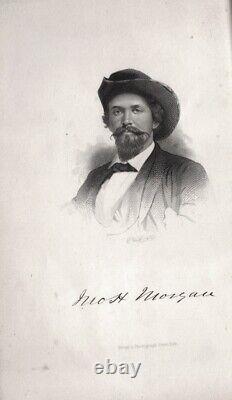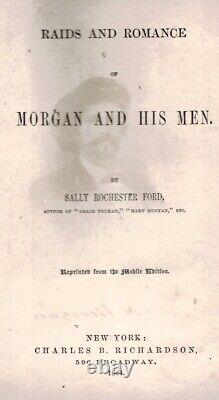
- Homepage
- Binding
- 1 / 2 Leather (2)
- 3 / 4 Leather (2)
- Brochure / Pamphlet (4)
- Cloth (87)
- Disbound (3)
- Fine Binding (52)
- Hard Back (2)
- Hard Cover (4)
- Hardback (6)
- Hardcover (891)
- Hardcover Sheepskin (2)
- Hardcover W / Jacket (5)
- Hardcovers (2)
- Leather (258)
- Original Blue Cloth (2)
- Quarter Leather (3)
- Softcover (3)
- Softcover, Wraps (42)
- ... (3552)
- Composition
- Fineness
- Language
- Region
- Theme
Very Rare 1864 CIVIL War Confederate Morgan Confederate Raider First Edition





OFFERED HERE is a VERY rare first edition from 1864, the penultimate year of the Civil War. Raids and Romance of Morgan and his Men, by Sally Rochester Ford. As published by Charles B.
Sized 8x5 inches, 417 pages. Bound in dark brown cloth. Some restoration to the spine cloth.
The Civil War was ongoing when this book was published. With a small owner bookplate from the 1860s, W. Collier, and a small bookstore label from a Philadelphia bookstore named Leary. We note that a William H. Collier, was a Florida Civil War veteran, serving from April 5, 1861, April 4, 1862, Promoted 1st Lieutenant, CO.
WE CAN NOT FIND ANOTHER COPY OF THIS FIRST EDITION ONLINE. THERE WAS A SERIAL RUN IN A MOBILE, ALABAMA NEWSPAPER (SEE BELOW) BUT NO COPIES SEEM TO EXIST. THE AUTHOR was very sympathetic to Morgan and the Confederate cause. During the war, SALLY ROCHESTER Ford was a refugee in Dixie, doing her utmost for the soldiers of the Confederate States Army.
For some time, in the later part of the war, Rev. Ford was stationed in Mobile, Alabama, The Raids and Romance of Morgan and his Men, which appeared serially in a weekly paper, was published by S. Goetzel, Mobile, on dingy paper, with wall paper covers, and was read and reread by campfires and in bivouacs.
We don't think any copies of the newspaper are available. Morgan's Raid (also the Calico Raid or Great Raid of 1863) was a diversionary incursion by Confederate cavalry into the Union states of Indiana, Kentucky, Ohio, and West Virginia during the American Civil War. The raid took place from June 11 to July 26, 1863. It is named for the commander of the Confederate troops, Brigadier General John Hunt Morgan. Although it caused temporary alarm in the North, the raid was ultimately classed as a failure.
The raid covered more than 1,000 miles (1,600 km), beginning in Tennessee and ending in northern Ohio. It coincided with the Vicksburg and Gettysburg Campaigns, and was meant to draw Union troops away from those fronts by frightening the North into demanding its troops return home. Despite his initial successes, Morgan was thwarted in his attempts to recross the Ohio River and eventually was forced to surrender what remained of his command in northeastern Ohio near the Pennsylvania border.
Morgan and other senior officers were held in the Ohio Penitentiary, but they tunneled their way out and took a train to Cincinnati, where they crossed the Ohio River into Kentucky. General Morgan and his 2,460 handpicked Confederate cavalrymen, along with four artillery pieces, departed from Sparta, Tennessee, on June 11, 1863.
The expedition's intent was to divert the attention of the Union Army of the Ohio from Southern forces in the state and possibly stir up pro-southern sentiments in the North. General Braxton Bragg, the regional Confederate commander, had intended for Morgan's cavalrymen to provide a distraction by entering Kentucky. Morgan, however, confided to some of his officers that he had long desired to invade Indiana and Ohio to bring the terror of war to the North. Bragg had given him carte blanche to ride throughout Tennessee and Kentucky, but ordered him to under no circumstances cross the Ohio River. On June 23, the Federal Army of the Cumberland began its operations against General Bragg's Confederate Army of Tennessee in what became known as the Tullahoma Campaign, and Morgan decided it was time to move northward into Kentucky.
The Battle of Tebbs' Bend. On July 2, hoping to disrupt Union communication lines, Morgan rode into Kentucky, where sympathetic citizens openly welcomed his cavalrymen. Crossing the rain-swollen Cumberland River at Burkesville, Morgan's division advanced to the Green River, where it was deflected by half of a Union regiment (the 25th Michigan Infantry) at the Battle of Tebbs Bend on July 4.
Morgan surprised and captured the garrison at Lebanon. He trapped 400 men from the 20th Kentucky in the town's railroad depot, but the well-fortified building provided considerable protection. In a six-hour fight, Federal troops killed Morgan's youngest brother, Thomas, during the Confederate's final charge. Morgan finally captured, and then paroled, the Federal troops. A grieving Morgan continued northward towards Louisville, riding through Springfield, Bardstown, and Garnettsville.
Along the way, the Confederates endured several more small skirmishes with Union troops and Kentucky home guard units. Just south of the city, however, he turned his remaining men to the northwest and headed for the Ohio River. At Springfield, Morgan sent a detachment north and east of Louisville, with the intention of confusing Union forces as to where Morgan was really heading. This detachment crossed the Ohio River at Twelve Mile Island, but they were captured near New Pekin, Indiana, before they could rejoin Morgan. To further mislead the Federals on his objectives, Morgan had his telegrapher, "Lightning" Ellsworth, tap telegraph lines and, pretending to be a Union telegrapher, send several messages giving different headings for the raiders and false reports of the size of Morgan's force-sometimes reporting it as high as 7,000 men. Ellsworth did this throughout the journey, especially in Indiana. Panic in Louisville as Morgan's troops approach; Drawing from Illustrated Battles of the Nineteenth Century, vol. Morgan had sent spy Thomas Hines and a party of 62 Confederates, posing as a Union patrol, on a secret mission into Indiana in June to determine if the local Copperheads would support or join Morgan's impending raid. After visiting the local Copperhead leader, Dr. Bowles, Hines learned that no desired support would be forthcoming. He and his scouts were soon identified as actually being Confederates, and, in a small skirmish near Leavenworth, Indiana, Hines had to abandon his men as he swam across the Ohio River under gunfire. He wandered around Kentucky for a week seeking information on Morgan's whereabouts.By now reduced to 1,800 men, Morgan's main column had arrived on the morning of July 8 at Brandenburg, Kentucky, a small town along the Ohio River, where Hines rejoined them. Here, the raiders seized two steamboats, the John B. McCombs and the Alice Dean.
Morgan, against Bragg's strict orders, [6] transported his command across the river to Indiana, landing just east of Mauckport. A small company of Indiana home guards contested the crossing with an artillery piece, as did a riverboat carrying a six-pounder. The gunboat soon fled, however, and Morgan's forces were able to safely cross into Indiana that night.
After burning the Alice Dean and sending the John B. McCombs downriver with instructions not to pursue him, Morgan headed away from the river. Morton worked feverishly to organize Indiana's defense, calling for able-bodied men to take up arms and form militia companies. Thousands responded and organized themselves into companies and regiments. Lewis Jordan took command of the 450 members of the Harrison County Home Guard (Sixth Regiment, Indiana Legion), consisting of poorly trained civilians with a motley collection of arms.His goal was to delay Morgan long enough for Union reinforcements to arrive. Ambrose Burnside, commander of the Department of the Ohio with headquarters in Cincinnati, quickly organized local Federal troops and home militia to cut off Morgan's routes back to the South. Morgan headed northward on Mauckport Road, with another brother, Colonel Richard Morgan, leading the forward elements. On July 9, one mile (1.6 km) south of Corydon, Indiana, the county seat of Harrison County, his advance guard encountered Jordan's small force, drawn in a battle line behind a hastily thrown up barricade of logs. The colonel attacked, and in a short but spirited battle of less than an hour, he simultaneously outflanked both Union wings, completely routing the hapless militia.
[10] Accounts vary as to the number of casualties that resulted from the Battle of Corydon, but one source estimates that 4 of Jordan's men were killed, 10-12 were wounded, and 355 were captured. Morgan counted 11 dead and 40 wounded raiders.
[11] Among the dead Federals was the civilian toll keeper who perished near his tollgate. Raiders killed a Lutheran minister, Reverend Peter Glenn, on his farm, 4 miles (6 km) from the battlefield, and stole horses from several other farmers.
General Morgan led his division into Corydon, where he paroled his demoralized prisoners and ransomed the town for cash and supplies. Morgan's soldiers then traveled east and reached Vienna on July 10, where they burned a railroad bridge and depot, and tapped a telegraph line.After spending the night in Lexington, they headed to the northeast, terrorizing the small towns along the way, including Vernon, Dupont, New Pekin, Salem, and Versailles. On July 11, while crossing Blue River near New Pekin, Confederate Capt.
Davis and some of his men were captured by 73rd Indiana Infantry and a detachment of the 5th U. Davis and several other soldiers were taken to New Albany and secured in the county jail. On the night of July 11, Morgan camped near the town of Dupont, Indiana. Subsequently, on July 12, his men burned the town's storehouse and stole 2,000 smoked hams before continuing east. By the next day, such a large amount of meat in the open air had attracted flies, and the soldiers began discarding hams along the side of the road, leaving a trail for Indiana militia troops to follow as they chased Morgan and his men out of the state.Morgan then headed for Salem where he immediately took possession of the town and placed guards over the stores and streets. His cavalrymen burned the large brick depot, along with all the railcars on the track and the railroad bridges on each side of town.
In Versailles a group of freebooters invaded the local Masonic Lodge, Versailles No. 7, and lifted the Lodge's badges of office which had originally been made from French silver coins. Morgan finally left Indiana at Harrison, closely pursued by Federal cavalry.
